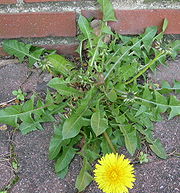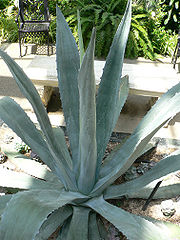
Rosette (botany)
Encyclopedia


Though rosettes usually sit near the soil, their structure is an example of a modified stem
Plant stem
A stem is one of two main structural axes of a vascular plant. The stem is normally divided into nodes and internodes, the nodes hold buds which grow into one or more leaves, inflorescence , conifer cones, roots, other stems etc. The internodes distance one node from another...
.
Function
Often, rosettes form in perennial plants whose upper foliage dies back with the remaining vegetation protecting the plant. Another form occurs when internodes along a stem are shortened, bringing the leaves closer together, as in lettuceLettuce
Lettuce is a temperate annual or biennial plant of the daisy family Asteraceae. It is most often grown as a leaf vegetable. It is eaten either raw, notably in salads, sandwiches, hamburgers, tacos, and many other dishes, or cooked, as in Chinese cuisine in which the stem becomes just as important...
and dandelion and some succulents. (When plants such as lettuce grow too quickly, the stem lengthens instead, a condition known as bolting.) In yet other forms, the rosette persists at the base of the plant (such as the dandelion), and there is a taproot
Taproot
A taproot is an enlarged, somewhat straight to tapering plant root that grows vertically downward. It forms a center from which other roots sprout laterally.Plants with taproots are difficult to transplant...
.
Protection
Part of the protective function of a rosette like the dandelion is that it is hard to pull from the ground; the leaves come away easily while the taproot is left intact.Another kind of protection is provided by the caulescent rosette which is part of the growth form of the giant Espeletia
Espeletia
Espeletia, commonly known as Frailejón or Fraylejón is a genus of perennial subshrubs, in the family Asteraceae. The genus, which is endemic mainly to Colombia, Venezuela and Ecuador, was first formally described by botanist Alexander Von Humboldt in 1801...
genus in South America, which has a well-developed stem above the ground. In tropical alpine environments a wide variety of plants in different plant families and different parts of the world have evolved this growth form characterized by evergreen rosettes growing above marcescent leaves. Examples where this arrangement has been confirmed to improve survival, help water balance, or protect the plant from cold injury are Espeletia
Espeletia
Espeletia, commonly known as Frailejón or Fraylejón is a genus of perennial subshrubs, in the family Asteraceae. The genus, which is endemic mainly to Colombia, Venezuela and Ecuador, was first formally described by botanist Alexander Von Humboldt in 1801...
schultzii and Espeletia timotensis, both from the Andes
Andes
The Andes is the world's longest continental mountain range. It is a continual range of highlands along the western coast of South America. This range is about long, about to wide , and of an average height of about .Along its length, the Andes is split into several ranges, which are separated...
.
Taxonomies
Many plant families have varieties with rosette morphology; they are particularly common in AsteraceaeAsteraceae
The Asteraceae or Compositae , is an exceedingly large and widespread family of vascular plants. The group has more than 22,750 currently accepted species, spread across 1620 genera and 12 subfamilies...
(such as dandelions), Brassicaceae
Brassicaceae
Brassicaceae, a medium sized and economically important family of flowering plants , are informally known as the mustards, mustard flowers, the crucifers or the cabbage family....
(such as cabbage
Cabbage
Cabbage is a popular cultivar of the species Brassica oleracea Linne of the Family Brassicaceae and is a leafy green vegetable...
), and Bromeliaceae
Bromeliaceae
Bromeliaceae is a family of monocot flowering plants of around 3,170 species native mainly to the tropical Americas, with a few species found in the American subtropics and one in tropical west Africa, Pitcairnia feliciana...
. The fern, Blechnum fluviatile
Blechnum fluviatile
Blechnum fluviatile is a fern known in the Māori language as kiwikiwi. A herbaceous plant, B. fluviatile is a "hard fern" of the Blechnum genus in the Blechnaceae family. It was identified by Patrick Brownsey in 1979. Other common names are star fern, creek fern, kawakawa and...
or New Zealand
New Zealand
New Zealand is an island country in the south-western Pacific Ocean comprising two main landmasses and numerous smaller islands. The country is situated some east of Australia across the Tasman Sea, and roughly south of the Pacific island nations of New Caledonia, Fiji, and Tonga...
Water Fern (Kiwikiwi) is a rosette plant.
Form
The rosette form is the structure, the relationship of the parts, and the variations within it, as shown in the following study from a herbariumHerbarium
In botany, a herbarium – sometimes known by the Anglicized term herbar – is a collection of preserved plant specimens. These specimens may be whole plants or plant parts: these will usually be in a dried form, mounted on a sheet, but depending upon the material may also be kept in...
:
- Dryas octopetalaDryas octopetalaDryas octopetala is an arctic-alpine flowering plant in the family Rosaceae. It is a small prostrate evergreen subshrub forming large colonies, and is a popular flower in rock gardens...
(White Dryas, Rosaceae) has a leaf rosette of leaf blades with a short petiolePetiole (botany)In botany, the petiole is the stalk attaching the leaf blade to the stem. The petiole usually has the same internal structure as the stem. Outgrowths appearing on each side of the petiole are called stipules. Leaves lacking a petiole are called sessile, or clasping when they partly surround the...
, slim, egg-shaped leaves with cordate bases with clearly and regularly toothed margins, and single flowers on usually long pedunclePeduncle (botany)In botany, a peduncle is a stem supporting an inflorescence, or after fecundation, an infructescence.The peduncle is a stem, usually green and without leaves, though sometimes colored or supporting small leaves...
s or stalks, two to four centimetres across. The flowers have seven to nine, often even more, white egg-shaped petals. The sepals are lanceolate. - Silene nutans (Nottingham Catchfly, Caryophyllaceae) shows ensiform-lanceolate leaves. The slightly rosette-like ground leaves are bigger and of different shape than the sparse, opposite leaves on the stem. This is explained in that side shoots with greatly prolonged internodes may spring from rosettes. They have one or more flowers at their tip, like the primrosePrimrose-Botany:* Primulaceae, a family of flowering plants* Primula vulgaris, commonly known as the Primrose * Oenothera, commonly known as Evening Primrose, a plant genus...
. Especially in biennial plants, the main shoot can, too, grow with prolonged internodes and even branch. It is not unusual that the leaves of the rosette and those of the shoot differ in shape.
As form then, "rosette" is used to describe plants that perpetually grow as a rosette and the immature stage of plants such as some ferns.
See also
- AsteraceaeAsteraceaeThe Asteraceae or Compositae , is an exceedingly large and widespread family of vascular plants. The group has more than 22,750 currently accepted species, spread across 1620 genera and 12 subfamilies...
- BromeliadBromeliaceaeBromeliaceae is a family of monocot flowering plants of around 3,170 species native mainly to the tropical Americas, with a few species found in the American subtropics and one in tropical west Africa, Pitcairnia feliciana...
- Bilbergia
- FernFernA fern is any one of a group of about 12,000 species of plants belonging to the botanical group known as Pteridophyta. Unlike mosses, they have xylem and phloem . They have stems, leaves, and roots like other vascular plants...
- Bird's Nest FernBird's Nest FernBird's-nest fern is a common name applied to several related species of ferns in the genus Asplenium. They grow in a tight, nest-like clump with a lingulate leaf rosette and are usually epiphytic, growing in trees...
- Ostrich FernOstrich fernThe ostrich fern or shuttlecock fern is a crown-forming, colony-forming fern, occurring in temperate regions of the Northern Hemisphere in eastern and northern Europe, northern Asia and northern North America....
- Wild Bird's-nest Fern
- Bird's Nest Fern

